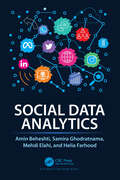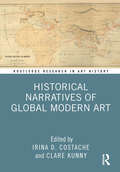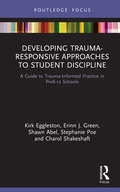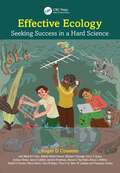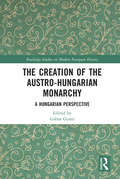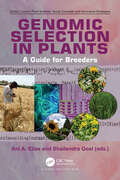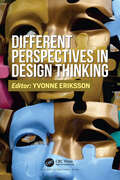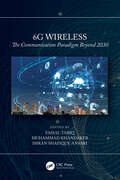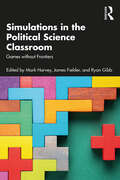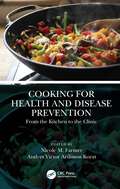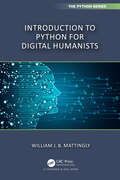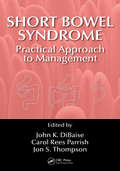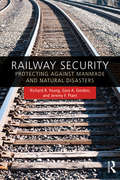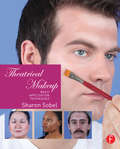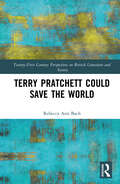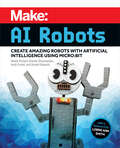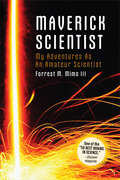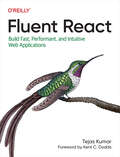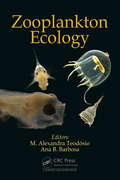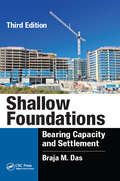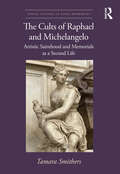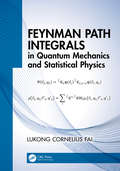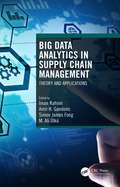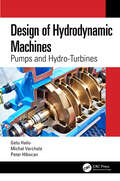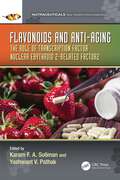- Table View
- List View
Social Data Analytics
by Amin Beheshti Samira Ghodratnama Mehdi Elahi Helia FarhoodThis book is an introduction to social data analytics along with its challenges and opportunities in the age of Big Data and Artificial Intelligence. It focuses primarily on concepts, techniques and methods for organizing, curating, processing, analyzing, and visualizing big social data: from text to image and video analytics. It provides novel techniques in storytelling with social data to facilitate the knowledge and fact discovery. The book covers a large body of knowledge that will help practitioners and researchers in understanding the underlying concepts, problems, methods, tools and techniques involved in modern social data analytics. It also provides real-world applications of social data analytics, including: Sales and Marketing, Influence Maximization, Situational Awareness, customer success and Segmentation, and performance analysis of the industry. It provides a deep knowledge in social data analytics by comprehensively classifying the current state of research, by describing in-depth techniques and methods, and by highlighting future research directions. Lecturers will find a wealth of material to choose from for a variety of courses, ranging from undergraduate courses in data science to graduate courses in data analytics.
Historical Narratives of Global Modern Art (Routledge Research in Art History)
by Irina D. Costache Clare KunnyDiversifying the current art historical scholarship, this edited volume presents the untold story of modern art by exposing global voices and perspectives excluded from the privileged and uncontested narrative of “isms.” This volume tells a worldwide story of art with expanded historical narratives of modernism. The chapters reflect on a wide range of issues, topics, and themes that have been marginalized or outright excluded from the canon of modern art. The goal of this book is to be a starting point for understanding modern art as a broad and inclusive field of study. The topics examine diverse formal expressions, innovative conceptual approaches, and various media used by artists around the world and forcefully acknowledge the connections between art, historical circumstances, political environments, and social issues such as gender, race, and social justice. The book will be of interest to scholars working in art history, imperial and colonial history, modernism, and globalization.
Developing Trauma-Responsive Approaches to Student Discipline: A Guide to Trauma-Informed Practice in PreK-12 Schools (Routledge Research in Education)
by Kirk Eggleston Erinn J. Green Shawn Abel Stephanie Poe Charol ShakeshaftBuilding on comprehensive research conducted in US schools, this accessible volume offers an effective model of school leadership to develop and implement school-wide, trauma-responsive approaches to student discipline.Recognizing that challenging student behaviours are often rooted in early experiences of trauma, the volume builds on a model from the Substance Abuse and Mental Health Services Administration (SAMHSA) to walk readers through the processes of realizing, recognizing, responding to, and resisting the impacts of trauma in school contexts. Research and interviews model an educational reform process and explain how a range of differentiated interventions including Positive Behaviour Interventions and Supports (PBIS), social-emotional learning (SEL), restorative justice, and family engagement can be used to boost student resilience and pro-social behaviour. Practical steps are supported by current theory, resources, and stories of implementation from superintendents, principals, and teachers. This text will benefit school leaders, teachers, and counsellors with an interest in restorative student discipline, emotional and behavioural difficulties in young people, and PreK-12 education more broadly. Those interested in school psychology, trauma studies, and trauma counselling with children and adolescents will also benefit from the volume.
Effective Ecology: Seeking Success in a Hard Science
by Roger D. CousensEcology is one of the most challenging of sciences, with unambiguous knowledge much harder to achieve than it might seem. But it is also one of the most important sciences for the future health of our planet. It is vital that our efforts are as effective as possible at achieving our desired outcomes. This book is intended to help individual ecologists to develop a better vision for their ecology – and the way they can best contribute to science. The central premise is that to advance ecology effectively as a discipline, ecologists need to be able to establish conclusive answers to key questions rather than merely proposing plausible explanations for mundane observations. Ecologists need clear and honest understanding of how we have come to do things the way we do them now, the limitations of our approaches, our goals for the future and how we may need to change our approaches if we are to maintain or enhance our relevance and credibility. Readers are taken through examples to show what a critical appraisal can reveal and how this approach can benefit ecology if it is applied more routinely.Ecological systems are notable for their complexity and their variability. Ecology is, as indicated by the title of this book, a truly difficult science. Ecologists have achieved a great deal, but they can do better. This book aims to encourage early-career researchers to be realistic about their expectations: to question everything, not to take everything for granted, and to make up their own minds.
The Creation of the Austro-Hungarian Monarchy: A Hungarian Perspective (Routledge Studies in Modern European History)
by Gábor GyániRecent collection of essays discusses the historical event and the multifarious consequences of the 1867 Compromise (Ausgleich, Settlement), conducted between the Habsburg monarch, Francis Joseph and the Hungarian political ruling class. The whole story has usually been narrated from a plainly Cisleithanian viewpoint. The present volume, the product of Hungarian historians, gives an insight into both the domestic and the international historical discourses about the Dual Monarchy. It also reveals the process of how the 1867 Compromise was conducted, and touches upon several of the key issues brought about by establishing a constitutional dual state in place of the absolutist Habsburg Monarchy. The emphasis is laid not on describing and explaining the path leading to the final and "inevitable" break-up of the Dual Monarchy, but on what actually held it together for half a century. The local outcomes of self-maintaining mechanisms were no less obvious in the Hungarian part of the Dual Monarchy, despite the many manifestations of an overt adversity toward it. The Creation of the Austro-Hungarian Monarchy will appeal to historians dealing especially with 19th-century European history, and is also essential reading for university students.
Genomic Selection in Plants: A Guide for Breeders (Current Plant Science)
by Ani A. EliasGenomic selection (GS) is a promising tool in the field of breeding especially in the era where genomic data is becoming cheaper. The potential of this tool has not been realized due to its limited adaptation in various crops. Marker Assisted Selection (MAS) has been the method of choice for plant breeders while using the genomic information in the breeding pipeline. MAS, however, fails to capture vital minor gene effects while focusing only on the major genes, which is not ideal for breeding advancement especially for quantitative traits such as yield. The main aim of statistical methodologies coming under the umbrella of GS on using the whole genome information is to predict potential candidates for breeding advancement while optimizing the use of resources such as land, manpower, and most importantly time. Lack of proper understanding of the methods and their applications is one of the reasons why breeders shy away from this tool. The book is meant for biologists, especially breeders, and provides a comprehensive idea of the statistical methodologies used in GS, guidance on the choice of models, and design of datasets. The book also encourages the readers to adopt GS by demonstrating the current scenarios of these models in some of the important crops among oilseeds, vegetables, legumes, tuber crops, and cereals. For ease of implementation of GS, the book also provides hands-on scripts on GS data design and modeling in a popular open-source statistical program. Additionally, prospective in GS model development and thereby enhancement in crop improvement programs is discussed.
Different Perspectives in Design Thinking
by Yvonne ErikssonGlobalization and digitalization are buzz words in contemporary society. They affect both our private and our professional lives. Society has become more diverse with easier access to information and to virtual platforms that gives us opportunity to be in touch with colleagues, friends, family, etc. at any time. A complex environment is emerging wherein internet of things and big data are being integrated with products, production systems, healthcare, and daily activity and play an important part in decision making. This has an impact on future designs and the role of designers. Responsible designers with a holistic perspective are needed.The book highlights several aspects of design thinking such as Information Design and Critical Design. The meaning of culture, gender and disabilities are also discussed. The functions of Information Design are changing from ‘showing the way’, instruction manuals and graphic design. It will affect among others, healthcare technology, smart products and Industry 4.0. Design thinking perspective that includes users from the entire chain and from the producer to the end user of the product or service, is needed. This will also require gender and culture issues to be taken into consideration in designing products and services. Design thinking methods and critical aspects of design will contribute to an inclusive society.
6G Wireless: The Communication Paradigm Beyond 2030
by Faisal Tariq Muhammad Khandaker Imran Shafique Ansari6G Wireless: The Communication Paradigm Beyond 2030 offers a thorough discussion of some key emerging technologies such as Intelligent Reflecting Surface (IRS), Unmanned Aerial Vehicles (UAV), Aerial Computing, Terahertz (THz) Communications, Non-Orthogonal Multiple Access (NOMA) and Rate Splitting Multiple Access (RSMA).The book provides a comprehensive coverage of the vision, requirements, use cases, enabling technologies, and challenges for the future 6G wireless communication systems. This includes discussions on how 6G and future IoT systems will enable extremely low latency healthcare systems, smart industry, haptic communications, programmable wireless environment (PWE), advanced VR/AR and holographic communications. IRS is expected to play a prominent role in 6G and the book thoroughly discusses the role of IRS in enabling physical layer security, UAV communications as well as D2D communications. It also explains channel modeling for IRS enabled PWE.Another key aspect of the book is that it provides a comprehensive discussion on security challenges of emerging 6G systems and their potential solutions. Apart from this, it also explains how blockchain techniques can be used for future IoT applications such as intelligent manufacturing and asset tracking.Written in tutorial style, the book is primarily intended for postgraduate students and researchers in the broad domain of wireless communications as well as research-active academics. The book can also be useful as a reference book for BSc/MSc project/thesis works.
Simulations in the Political Science Classroom: Games without Frontiers
by Mark HarveyThis book is premised on the assumption that games and simulations provide welcome alternatives and supplements to traditional lectures and class discussions—especially in political science classrooms, where real-world circumstances provide ideal applications of theory and policy prescriptions. Implementing such an active learning program, however, is sometimes daunting to overburdened professors and teaching assistants. This book addresses the challenges of using games and simulations in the political science classroom, both online and in person. Each chapter offers a game or simulation that politics teachers can use to teach course concepts and explains ways to execute it effectively. In addition, the authors in this volume make a proactive case for games and simulations. Each chapter offers research to evaluate the effectiveness of the activity and pedagogical design best practices. Thus, the book not only serves as a game design resource, but also offers demonstrable support for using games and simulations in the political science classroom. Aimed at teachers at all levels, from high school through college, the book may be especially appealing to graduate students entering teaching for the first time and open to new teaching and learning approaches.
Cooking for Health and Disease Prevention: From the Kitchen to the Clinic
by Nicole M. FarmerPoor diet and substandard nutrition are underlying causes of many diseases including cardiovascular disease, diabetes, and cancer. Collectively, these ailments are the leading causes of premature death, most of which are preventable. Cooking for Health and Disease Prevention: From the Kitchen to the Clinic helps demonstrate cooking as a fundamental bridge between ideal nutrition and long-term health. Clinicians, patients, and the public often lack adequate knowledge to help select and prepare foods for optimal disease management. This book provides information to clinicians and their patients about foods and cooking principles to help prevent common health conditions.Features: Focuses on disease endpoints, reviewing the disease biology and epidemiology and presenting dietary interventions for disease prevention. Provides recommendations for translating dietary and culinary principles of health prevention into clinical practice and includes a recipe appendix with practical examples. Features information on healthy cooking techniques as well as food selection, storage, and preparation to help maximize nutritional value. Introduces the reader to fundamental concepts in nutrition and culinary principles explaining the relationship between food processing and food preparation and nutritional quality of foods. This book is accessible to patients and offers evidence-based practical interventions for healthcare professionals. It is authored by Nicole Farmer, physician scientist at the NIH Clinical Center, and nutrition researcher Andres Ardisson Korat, awarded a doctorate degree in nutrition and epidemiology from the Harvard T.H. Chan School of Public Health.
Introduction to Python for Humanists (Chapman & Hall/CRC The Python Series)
by William MattinglyThis book will introduce digital humanists at all levels of education to Python. It provides background and guidance on learning the Python computer programming language, and as it presumes no knowledge on the part of the reader about computers or coding concepts allows the reader to gradually learn the more complex tasks that are currently popular in the field of digital humanities. This book will be aimed at undergraduates, graduates, and faculty who are interested in learning how to use Python as a tool within their workflow. An Introduction to Python for Digital Humanists will act as a primer for students who wish to use Python, allowing them to engage with more advanced textbooks. This book fills a real need, as it is first Python introduction to be aimed squarely at humanities students, as other books currently available do not approach Python from a humanities perspective. It will be designed so that those experienced in Python can teach from it, in addition to allowing those who are interested in being self-taught can use it for that purpose.Key Features: Data analysis Data science Computational humanities Digital humanities Python Natural language processing Social network analysis App development
Short Bowel Syndrome: Practical Approach to Management
by John K. DiBaiseShort Bowel Syndrome: Practical Approach to Management is the first reference exclusively about the issues experienced by patients with a short bowel. It covers all aspects of normal and abnormal physiology, the presenting features, and outcomes, including metabolic problems, gallstones, and renal stones. It discusses both medical and surgical treatments, including intestinal transplantation.The use of growth factors, which is likely in the future to become increasingly important in promoting intestinal structural adaptation, is extensively discussed. Special emphasis is given to the psychosocial aspects of the quality of life of patients, including support groups. Emphasis is also given to the importance of an experienced multidisciplinary team in caring for these patients.This book is particularly timely given the recent advances in the management of Short Bowel Syndrome, including the availability of pharmacologic agents to enhance intestinal absorption, refinements in parenteral nutrition, and surgical procedures designed to eliminate the need for parenteral nutrition support.The goal of this international, interdisciplinary book is to bring the subject of Short Bowel Syndrome to a wide audience. A wide range of specialists have contributed to this book to provide various viewpoints on the state-of-the-art care of those with this condition.
Railway Security: Protecting Against Manmade and Natural Disasters
by Richard R. Young Gary A. Gordon Jeremy F. PlantThis book provides an overview and assessment of the security risks, both manmade and natural, facing the railways and rail networks.Railroads face significant threats from disasters, but with situational awareness and coordinated effort these can often be substantially minimized. Transportation assets have always been vulnerable to natural disasters, but in the current environment these assets are also a preferred target of human-caused disruption, especially in the form of terrorism, as the events in many other parts of the world have underscored. Railways are not a homogeneous mode of transportation given their various roles in intercity and commuter passenger movement, as well as being a major portion of the freight ton-miles upon which the U.S. economy is highly dependent. Designed to provide advice for railway owners and first responders, this text discusses how to secure hazardous material transport and how to establish guidelines for rail freight operations and rail passenger operations. The book aims to develop an understanding of the unique operating characteristics of railways, the nature and the range of vulnerabilities, the present means for protecting the infrastructure, and the public policy initiatives that are prerequisite for developing a comprehensive appreciation of the magnitude of this issue. The book utilizes case studies of transport disasters to illustrate lessons learned and to provide critical insight into preventative measures.This book will be of great interest to students and practitioners of transportation, technology and engineering, and security management.
Theatrical Makeup: Basic Application Techniques
by Sharon SobelTheatrical Makeup clearly and concisely explains the basics of theatrical makeup techniques to allow stage actors to put their best face forward! Readers will gain understanding of the physiology of the human face and, using cream based makeup, as well as commercial cosmetics, learn how to contour it to suit the character with the use of highlight and shadow. Hundreds of full color images and step-by-step instructions illustrate how to visually manipulate bone structure and apparent age, apply simple facial hair and wounds, and create glamorous and natural stage makeup. Also covered are the tools readers will need to apply their own makeup, along with critical health and hygiene tips. This book is suitable for beginner Theatrical Makeup courses and for stage actors of all levels.
Terry Pratchett Could Save the World (21st Century Perspectives on British Literature and Society)
by Rebecca Ann BachThis monograph contends that attending to Pratchett’s work could help to save our world. It draws attention to the astonishing capacity of Pratchett’s novels to inspire and argues that Pratchett’s fantasy novels directly address many of the most significant challenges people in the world face: the explosion of weapons technology; the myriad issues involved in the envelopment of human life by corporatized information technology; the destructive human inattention to, and interactions with, the Earth and its life forms; and the problem of devalued labor. Paradoxically, it is Pratchett’s choice of fantasy that lets him address the reality of major issues that humanity and the rest of life confront now. Pratchett’s novels show us how to better understand and confront the problems the world is contending with. The book will interest both scholars and fans.
Make: AI Robots
by Reade Richard Brenda Shivanandan Andy Forest Denzel EdwardsArtificial intelligence is a tool to explore and create, and it starts here with the experts at Steamlabs, a nonprofit that teaches teens to not just be users of technology, but to create with technology so they can be help shape our future.Make: AI Robots introduces young people to AI through exciting craft projects that start with a mechanical cardboard creation, integrates fun electronic lights and motors, adds simple coding on a micro:bit, and then teaches how to train AI to create a spark of life.With 32 projects designed to guide beginners through increasing challenges, Make: AI Robots is the perfect way to feed curious minds with fun AI experiments that will delight and inspire.
Make: Maverick Scientist
by Forrest M. MimsMaverick Scientist is the memoir of Forrest Mims, who forged a distinguished scientific career despite having no academic training in science. Named one of the "50 Best Brains in Science" by Discover magazine, Forrest shares what sparked his childhood curiosity and relates a lifetime of improbable, dramatic, and occasionally outright dangerous experiences in the world of science.At thirteen he invented a new method of rocket control. At seventeen he designed and built an analog computer that could translate Russian into English and that the Smithsonian collected as an example of an early hobby computer. While majoring in government at Texas A&M University, Forrest created a hand-held, radar-like device to help guide the blind. And during his military service, he had to be given special clearance to do top secret laser research at the Air Force Weapons Lab. Why? Because while he lacked the required engineering degree, they wanted his outside-the-box thinking on the project.He went on to co-found MITS, Inc., producer of the first commercially successful personal computer, wrote a series of electronics books for Radio Shack that sold more than seven million copies, and designed the music synthesizer circuit that became known as the infamous Atari Punk Console. All this came before he started consulting for NASA's Goddard Space Flight Center, and NOAA's famous Mauna Loa Observatory, and earning the prestigious Rolex Award.This intimate portrait of a self-made scientist shares a revelatory look inside the scientific community, and tells the story of a lifelong learner who stood by his convictions even when pressured by the establishment to get in line with conventional wisdom. With dozens of personal photos and illustrations, Maverick Scientist serves as proof that to be a scientist, you simply need to do science.
Fluent React
by Tejas KumarWhen it comes to building user interfaces on the web, React enables web developers to unlock a new world of possibilities. This practical book helps you take a deep dive into fundamental concepts of this JavaScript library, including JSX syntax and advanced patterns, the virtual DOM, React reconciliation, and advanced optimization techniques. By becoming fluent in React, you'll quickly learn how to build better web applications.Author Tejas Kumar helps you explore the depths of React in plain English, without the typical software engineering jargon, so you can more easily understand how this JavaScript library works. You'll learn how to write intuitive React code that fully understands the nuances and layers of React, unlocking a whole new level of fluency.You will:Understand how React works at a deeper levelWrite React apps while optimizing them along the wayBuild resilient React applications that work well at arbitrary scaleCreate React applications for other platforms adjacent to the web and mobile devicesKnow when to reach for different mechanisms exposed by React, such as reducers versus state versus refs
Zooplankton Ecology
by M. Alexandra Teodósio and Ana B. BarbosaThis book aims at providing students and researchers an advanced integrative overview on zooplankton ecology, covering marine and freshwater organisms, from microscopic phagotrophic protists, to macro-jellyfishes and active fish larvae. The first book section addresses zooplanktonic organisms and processes, the second section is devoted to zooplankton spatial and temporal distribution patterns and trophic dynamics, and the final section is dedicated to emergent methodological approaches (e.g., omics). Book chapters include comprehensive synthesis, observational and manipulative studies, and sediment-based analysis, a vibrant imprint of benthic-pelagic coupling and ecosystem connectivity. Most chapters also address the impacts of anticipated environmental changes (e.g., warming, acidification).
Shallow Foundations: Bearing Capacity and Settlement, Third Edition
by Braja M. DasFollowing the popularity of the previous edition, Shallow Foundations: Bearing Capacity and Settlement, Third Edition, covers all the latest developments and approaches to shallow foundation engineering. In response to the high demand, it provides updated data and revised theories on the ultimate and allowable bearing capacities of shallow foundations. Additionally, it features the most recent developments regarding eccentric and inclined loading, the use of stone columns, settlement computations, and more. Example cases have been provided throughout each chapter to illustrate the theories presented.
The Cults of Raphael and Michelangelo: Artistic Sainthood and Memorials as a Second Life (ISSN)
by Tamara SmithersThis study explores the phenomenon of the cults of Raphael and Michelangelo in relation to their death, burial, and posthumous fame—or second life—from their own times through the nineteenth century.These two artists inspired fervent followings like no other artists before them. The affective response of those touched by the potency of the physical presence of their art- works, personal effects, and remains—or even touched by the power of their creative legacy—opened up new avenues for artistic fame, divination, and commemoration. Within this cultural framework, this study charts the elevation of the status of dozens of other artists in Italy through funerals and tomb memorialization, many of which were held and made in response to those of Raphael and Michelangelo.By bringing together disparate sources and engaging material as well as a variety of types of artworks and objects, this book will be of great interest to anyone who studies early modern Italy, art history, cultural history, and Italian studies.
Feynman Path Integrals in Quantum Mechanics and Statistical Physics
by Lukong Cornelius FaiThis book provides an ideal introduction to the use of Feynman path integrals in the fields of quantum mechanics and statistical physics. It is written for graduate students and researchers in physics, mathematical physics, applied mathematics as well as chemistry. The material is presented in an accessible manner for readers with little knowledge of quantum mechanics and no prior exposure to path integrals. It begins with elementary concepts and a review of quantum mechanics that gradually builds the framework for the Feynman path integrals and how they are applied to problems in quantum mechanics and statistical physics. Problem sets throughout the book allow readers to test their understanding and reinforce the explanations of the theory in real situations.Features: Comprehensive and rigorous yet, presents an easy-to-understand approach. Applicable to a wide range of disciplines. Accessible to those with little, or basic, mathematical understanding.
Big Data Analytics in Supply Chain Management: Theory and Applications
by Iman Rahimi, Amir H. Gandomi, Simon James Fong, and M. Ali ÜlküIn a world of soaring digitization, social media, financial transactions, and production and logistics processes constantly produce massive data. Employing analytical tools to extract insights and foresights from data improves the quality, speed, and reliability of solutions to highly intertwined issues faced in supply chain operations.From procurement in Industry 4.0 to sustainable consumption behavior to curriculum development for data scientists, this book offers a wide array of techniques and theories of Big Data Analytics applied to Supply Chain Management. It offers a comprehensive overview and forms a new synthesis by bringing together seemingly divergent fields of research. Intended for Engineering and Business students, scholars, and professionals, this book is a collection of state-of-the-art research and best practices to spur discussion about and extend the cumulant knowledge of emerging supply chain problems.
Design of Hydrodynamic Machines: Pumps and Hydro-Turbines
by Getu Hailu Michal Varchola Peter HlbocanDesign of Hydrodynamic Machines provides a broad, yet concise, theoretical background on the relationship between fluid dynamics and geometry. It covers the most important types of turbomachinery used in power generation industrial processes, utilities, and the oil and gas industry. Offering guidance on the hydraulic design aspect of different parts of turbomachinery, such as impellers, diffusers, volute casing, inlet and outlets, the book discusses how to conduct performance characteristics testing and evaluate performance parameters of the designed parts. It also covers aspects of CFD of turbomachinery. Readers will be able to perform hydraulic design of important turbomachinery parts using commercially available software.Intended for final year undergraduates and postgraduates in mechanical, civil, and aeronautical engineering, the book will also be useful for those involved in the hydraulic design, analysis, and testing of turbomachinery.
Flavonoids and Anti-Aging: The Role of Transcription Factor Nuclear Erythroid 2-Related Factor2 (Nutraceuticals)
by Karam F.A. SolimanThe nuclear factor erythroid 2-related factor 2 (Nrf2) was described as a master regulator of the cellular antioxidant response. Moreover, many critical biological functions linked to cell viability, metabolism, autophagy, inflammation, immunity, and differentiation have been attributed to Nrf2, which regulates over 600 genes. It is well known that oxidative stress, which Nrf2 can ameliorate, plays a key role in many pathologic processes such as aging, obesity, diabetes, cancer, and neurodegenerative diseases. Flavonoids, on the other hand, through their ability to activate and upregulate Nrf2, can have anti-oxidative, anti-inflammatory, anti-mutagenic, and anti-carcinogenic properties. Flavonoids are an essential ingredient in nutraceuticals, functional foods, and pharmaceuticals. The present book Flavonoids and Anti-Aging: The Role of Transcription Factor Nuclear Erythroid 2-Related Factor2 focuses on the interaction between Nrf2 and flavonoids and their applications in various conditions such as aging, osteoporosis, cardiovascular diseases, and neurodegenerative disease and many other areas. Key Features: Focuses on the mechanisms and use of flavonoids in activating Nrf2 as an anti-aging and "WELLNESS" molecule Provides a specific approach to flavonoid activation of Nrf2 and its implications in aging and various disease conditions and its applications as nutraceuticals Presents flavonoid-based functional foods Discusses the flavonoid nutraceuticals market and future trends Written by experts in the field, this book provides a unique approach to understanding the flavonoid activation of the transcription factor Nrf2, which is responsible for many different disease conditions due to increased reactive oxidative species in the body caused by some physiological triggers.
